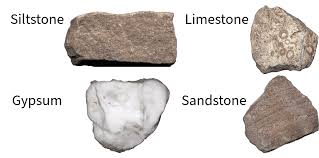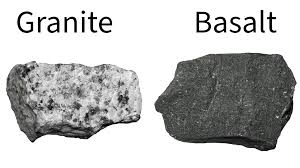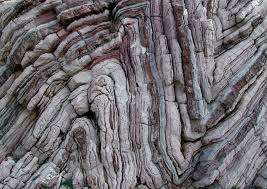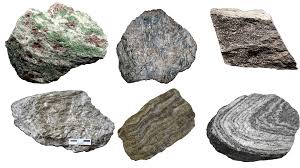

Three Main Types of Rocks: Sedimentary, Igneous, and Metamorphic:
The Earth’s crust is composed of various types of rocks that have been formed over millions of years through geological processes. Rocks are naturally occurring solid masses of mineral material, and they can be classified into three main categories: sedimentary, igneous, and metamorphic rocks. These rock types are formed through the rock cycle, a continuous process that involves the transformation of one rock type into another.

Sedimentary rocks are formed through the accumulation and compression of sediments, such as mineral particles, organic matter, and fragments of pre-existing rocks. These sediments can come from a variety of sources, including erosion, weathering, and biological activities. Over time, the sediments are compressed and cemented together to form a new rock.
Sedimentary rocks are typically characterized by their layered or bedded appearance, which reflects their formation process. They can also contain fossils, which are remains or traces of ancient plants and animals. Sedimentary rocks can be further classified into three subcategories: clastic, chemical, and organic sedimentary rocks.
Examples of sedimentary rocks include shale, limestone, sandstone, and conglomerate. Shale is a fine-grained rock formed from clay particles, while limestone is a calcium carbonate rock formed from the accumulation of marine fossils. Sandstone is a coarse-grained rock formed from sand-sized mineral particles, and conglomerate is a rock formed from a mixture of mineral particles and rock fragments.

Sedimentary rocks are formed through a variety of processes, including mechanical weathering, chemical weathering, erosion, and deposition. Mechanical weathering involves the physical breakdown of rocks into smaller particles, while chemical weathering involves the chemical alteration of rocks. Erosion involves the removal of sediments from one location and their transportation to another, while deposition involves the settling of sediments in a new location.
Igneous rocks are formed through the cooling and solidification of magma or lava. Magma is molten rock that forms beneath the Earth’s surface, while lava is molten rock that erupts from volcanoes. Igneous rocks can be formed through two main processes: intrusive and extrusive.

Igneous rocks are typically characterized by their glassy appearance and lack of layering or bedding. They can also contain gas bubbles or mineral crystals, which reflect their formation process. Igneous rocks can be further classified into two subcategories: intrusive and extrusive igneous rocks.
Examples of igneous rocks include granite, basalt, and obsidian. Granite is a coarse-grained rock formed from the slow cooling of magma deep beneath the Earth’s surface. Basalt is a fine-grained rock formed from the rapid cooling of lava flows. Obsidian is a glassy rock formed from the rapid cooling of lava.

Igneous rocks are formed through the cooling and solidification of magma or lava. Intrusive igneous rocks are formed when magma cools and solidifies beneath the Earth’s surface, while extrusive igneous rocks are formed when lava cools and solidifies above the Earth’s surface.

Metamorphic rocks are formed through the alteration of pre-existing rocks under high pressure and temperature conditions. This process can occur due to tectonic forces, such as mountain building, or through contact metamorphism, where rocks are exposed to heat and fluids from magma or other sources.
Metamorphic rocks are typically characterized by their foliated or banded appearance, which reflects their formation process. They can also contain mineral crystals or other structures that are not found in the original rock. Metamorphic rocks can be further classified into two subcategories: foliated and non-foliated metamorphic rocks.

Examples of metamorphic rocks include marble, slate, and quartzite. Marble is a metamorphic rock formed from the alteration of limestone or dolostone. Slate is a fine-grained rock formed from the alteration of shale or mudstone. Quartzite is a metamorphic rock formed from the alteration of sandstone or chert.
Metamorphic rocks are formed through the alteration of pre-existing rocks under high pressure and temperature conditions. This process can occur due to tectonic forces, such as mountain building, or through contact metamorphism, where rocks are exposed to heat and fluids from magma or other sources.
In conclusion, sedimentary, igneous, and metamorphic rocks are the three main types of rocks that make up the Earth’s crust. Each type of rock has its own unique characteristics, formation processes, and examples. Understanding the differences between these rock types is essential for understanding the Earth’s geology and the rock cycle. By studying the characteristics and formation processes of each type of rock, we can gain a deeper appreciation for the complexity and beauty of the Earth’s natural world.
